 Back to selection
Back to selection
Shutter Angles
Conversations with DPs, directors and below-the-line crew by Matt Mulcahey
“The Silliest Use of IMAX in the History of IMAX”: DP Larkin Seiple on Everything Everywhere All at Once
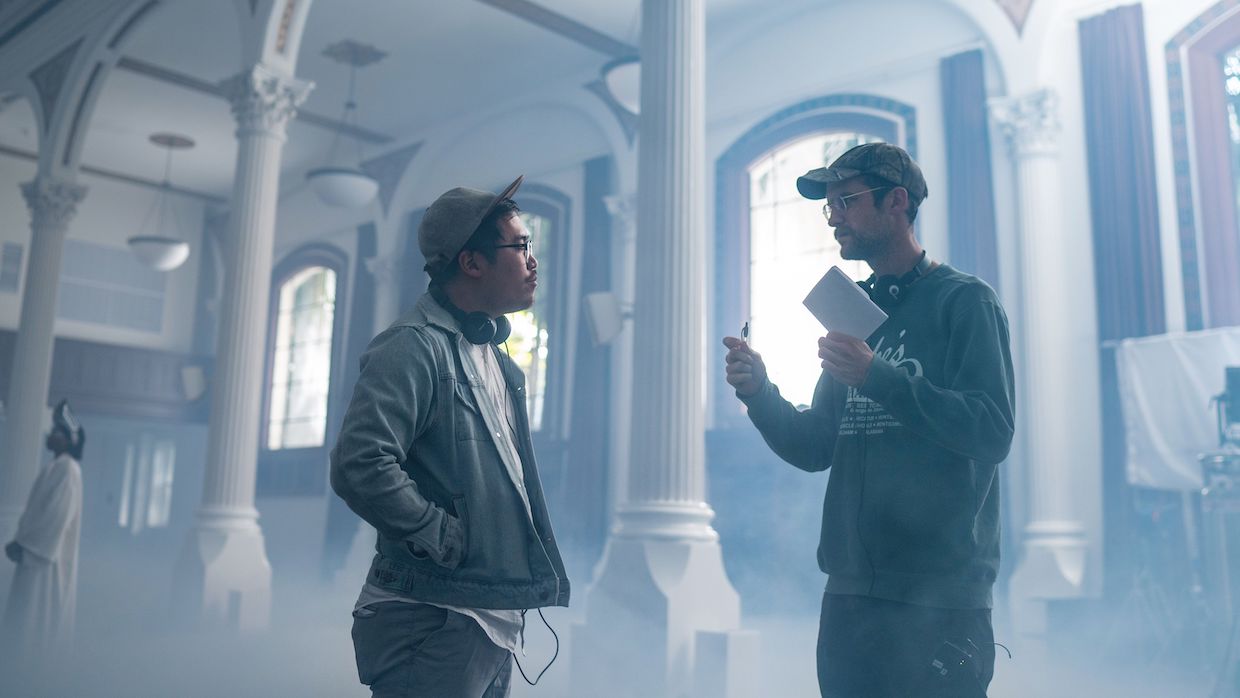 Daniels on the set of Everything Everywhere All at Once
Daniels on the set of Everything Everywhere All at Once “A messy but fun way to make something very stupid but very beautiful.” That’s how cinematographer Larkin Seiple describes the process of creating the multiverse-jumping singularity that is Everything Everywhere All at Once, a mixture of the silly and profound that careens through alternate realities populated with hot dog fingers, butt plugs and raccoon versions of Ratatouille while imploring us to embrace the fleeting moments of grace offered up by the universe in the face of our cosmic insignificance.
Michelle Yeoh stars as Evelyn, a harried laundromat owner whose marriage, mother-daughter relationship and IIRS audit all crater simultaneously. Into that personal maelstrom arrives an alternate version of Yeoh’s husband (Ke Huy Quan), who informs her she is just one of an infinite number of Evelyns from a sprawling multiverse that only she can save from destruction.
The film reteams Seiple with directors Daniel Kwan and Daniel Scheinert (known collectively as Daniels), whose previous effort, Swiss Army Man, offered another high-concept amalgam of absurdity and humanism. With Everything Everywhere still in wide release, Seiple spoke to Filmmaker about the making of a rare original, mid-budget box office breakthrough in a post-COVID theatrical landscape dominated almost exclusively by IP tentpoles.
Filmmaker: You have a few pictures on your Instagram feed from the last day of the Everything Everywhere shoot, featuring googly-eyed rocks conversing on the precipice of a canyon. You described that day as “a group of friends trying hard to make something great out of something stupid,” which seems applicable to so much of the craziness in this movie.
Seiple: It was an apt way of ending the film, in that we were pushing the limits of how far we would go for one shot. That location was about four hours south of LA It was a pick-up shoot after we’d been shut down from COVID. So, we’re all masked out there and it’s 115 degrees. We spent a whole day scouting it, then went back to shoot. Because of how long the drive was, we only had about six hours to actually shoot it and we’d already gotten two cars stuck in the sand just getting out there but made it work. It was really absurd and silly to travel all that way for what was originally supposed to be just one shot, but it was probably my favorite memory [of the shoot]. At that point it was just the core crew —me, the directors, a producer, [production designer] Jason Kisvarday and the rocks.
We had originally talked about just going to a forest and shooting there or trying to find somewhere close to the stages. I pitched to Daniels that I knew this amazing place where I proposed to my wife ten years ago. I showed them a photo and they were like, “Well, it’s the pandemic and we’re not doing anything. Might as well go and check it out.”
We originally wanted to shoot that scene in IMAX. We were like, “We can just get 200 feet of film, an IMAX camera and shoot this one shot. It would be the silliest use of IMAX in the history of IMAX.” But, of course, time and budget forbid it. We ended up renting Master Prime lenses for it. Looking back now, I kind of wish we had shot large format for that just to make the absurdity even stronger.
Filmmaker: Did you just scoot the rocks with some sort of stick that you painted out in post?
Seiple: We tried a couple of ways. We basically built a stick with a small flat end, almost like a shovel, and put that under the rock to get it to wiggle, then slowly pushed it. Eventually, we started putting our hands in there and moving them around. I think it became a fair amount of visual effects to clean up and hide things, like boot prints in the sand that were in the shot.
We thought we were in the middle of nowhere, but when we got to our final shot some locals showed up with a bottle of wine and set up chairs on the plateau across from us to watch the sunset. So, we had to paint them out as well, because we weren’t going to ask them to leave and ruin the end of their day.
Filmmaker: You mentioned getting shut down by COVID,. How much did you have left to shoot?
Seiple: We were shooting the Wong Kar-wai universe in a downtown alley in the middle of the rain on a Friday night, and that morning one of the producers had told us, “This is the last hurrah.” We basically had two green screen days left to shoot after that,. There’s a big fight at the end of the film where Evelyn is fighting her daughter trying to tell her that she loves her. We flash through all these different worlds as they’re fighting. Each hit changes the universe they’re in. It was this big, scary greenscreen thing with lots of interactive lighting. It was a huge bummer [that those days were postponed], because everyone just wanted to finish the movie. It had been a wild ride. Those greenscreen scenes became a lot harder as pick-ups, because Michelle was in Paris. So, we had to basically shoot (a pick-up day) of the whole fight sequence with Stephanie Hsu, who plays Evelyn’s daughter, and Michelle’s double on greenscreen. Then we took all of those lighting plans and sent them to Paris, where a friend of mine named Kanamé Onoyama replicated our set-up and shot Michelle’s portion of the fight. We were watching over Zoom while they were shooting and still programming all the lighting cues from here remotely. It was a lot of work for maybe about one minute of the film.
There’s another scene in what we called “The Tax Verse” where, instead of fighting, Michelle goes back, finishes her taxes and gets divorced from her husband Waymond. There’s a whole sequence where she’s in a van parked in the parking lot outside the building and Michelle is entirely greenscreened into that scene. In Paris they built a van [interior] out of grip stuff to create the shape of a windshield and a ceiling of a van and we just comped her into the shot, which I don’t think you can really tell.
Filmmaker: You talked about how much effort went into that fighting-through-the-universes montage that ends up being about a minute long. There are so many bits like that in the movie. For example, there’s a shot from the universe where Evelyn is a martial arts star where there’s a snap zoom out that reveals an entire film crew. It’s a ton of logistics to set that shot up for what’s ultimately about 48 frames of screen time.
Seiple: We spent about 30 days of the shoot in the location that we used for the IRS building, which I think was a mortgage lending firm that shut down during the last recession. After that, we had two weeks of chaos. There are these stages in L.A., DC Stages, that literally have like 40 sets in them. So, we had one day where it was like, “We’re going to shoot the prison. We’re going to shoot Michelle as an action star. We’re going to shoot Michelle as a pizza spinner.” We basically had one shot per set and leapfrogged from set to set trying to get everything.
Our theory for the movie was that it’s so fast that basically 10 percent of it had to be really good and everything else just had to work. But what happened was that different departments would fall in love with all of these little scenes that were just supposed to be “good enough” and would keep pushing them to another level to make them great.
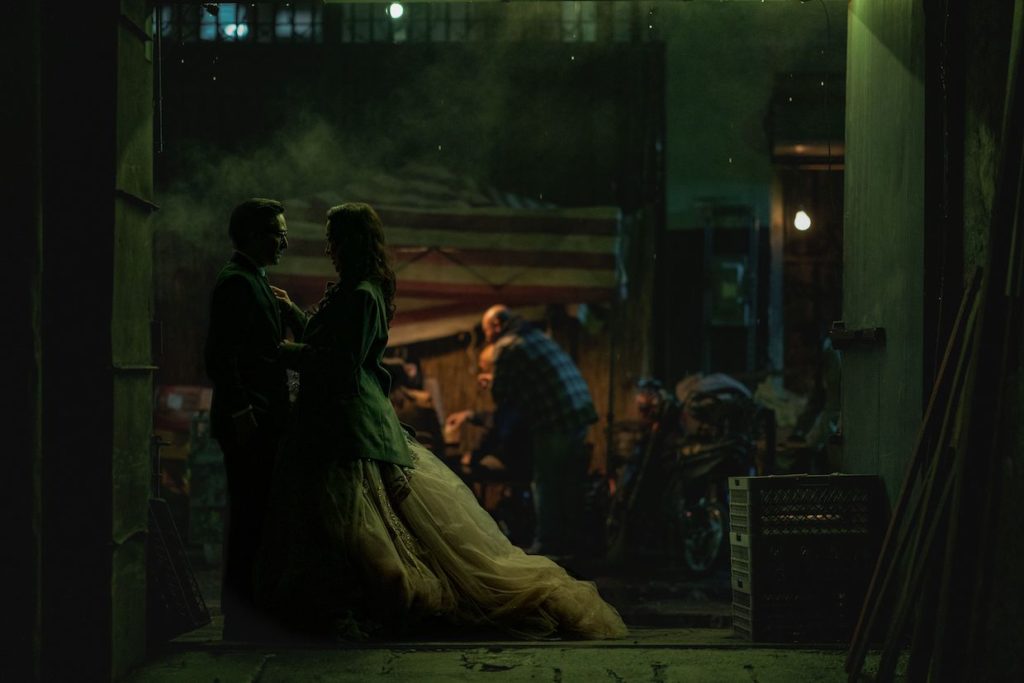
Filmmaker: Some of the universes are differentiated by shifts in aspect ratio. What other ways did you modify the look of the multitude of worlds?
Seiple: In preproduction we took a camera to the laundromat and IRS building and shot a bunch of footage of Michelle and her double just walking around. We started playing around with that to figure out what the normal world would look like. Then we started testing out lighting for all these other universes. For the “Action Verse,” where Ke becomes this badass martial arts star, we transitioned to anamorphic to create this classic 1990s action film star vibe, kind of like Die Hard. That movie was a little bit of a theme for us—they’re going through a building trying to survive, entering stairwells, entering abandoned construction sites. The “Hot Dog Verse” was pretty fun. We shot that on Baltars and used all hard light. We built a LUT that was based on The Sound of Music, which was really fun. (laughs)
The funny part about building all the universes was that we referenced a lot of different movies, but then realized that the way we wanted them to look wasn’t actually how the films looked in reality. It was more our memories of the films. The “Wong Kar-wai Verse” is much more saturated than, say, In the Mood for Love. There are moments that are colorful in that film and that’s what our brains kind of connected to,, even though that movie is more naturally exposed with kind of clean light. Same thing with the “Bagel Verse,” which was a mishmash of references. I had my personal references for things, like for the “Bagel Verse” it was Beyond the Black Rainbow and The NeverEnding Story II, which has this weird crystalline palace in it.
Filmmaker: Wait, did you say The Never EndingStory II? (laughs)
Seiple: Yeah. I would not recommend rewatching it. My memory of it was far superior to the actual film. The production value is very, very low compared to what my memory was, but it was just this idea of this evil place that’s delicate and beautiful.
There’s also the “Alpha Verse,” where Alpha Waymond is in his RV cruising through an apocalyptic desert. Costumes had done such a wild job of creating these Alpha Jumper suits that it felt kind of like the Battle of Hoth from The Empire Strikes Back. So, even though it’s a hot desert, it feels cold and blown out.
The Raccacoonie universe highly referenced 1990s Paul Thomas Anderson movies. We didn’t have nearly the time or money to do it the right way, but we referenced Magnolia for the chef sequences, with these really strong reds and blues and full, fleshy skin tones. We wanted to continue that into the night scenes but weren’t able to do it properly. If you watch Magnolia there’s some amazing backlight and flares and the same thing with Punch-Drunk Love. We wanted to continue that theme, but we basically maxed out our budget trying to get the stunt rig we needed to put Michelle onto Harry [Shum’s] shoulders to run down the street. The only thing we could afford to do was just use whatever streetlights were already there.
Filmmaker: I laughed every single time I saw that raccoon puppet.
Seiple: It was actually supposed to look a lot worse. The directors were like, “It can literally be a bag of fur with google eyes. That’s all we need.” We had an amazing special effects artist named Jason Hamer, who worked with us on Swiss Army Man. He built this raccoon that could move its head, blink, open its mouth, move its hands. We were all blown away. No one was expecting the raccoon to be that good, but again, all these departments, found something they loved and were like, “I want to push this as far as we can.” You don’t ever get to do something as absurd as that. It’s such a rare treat.
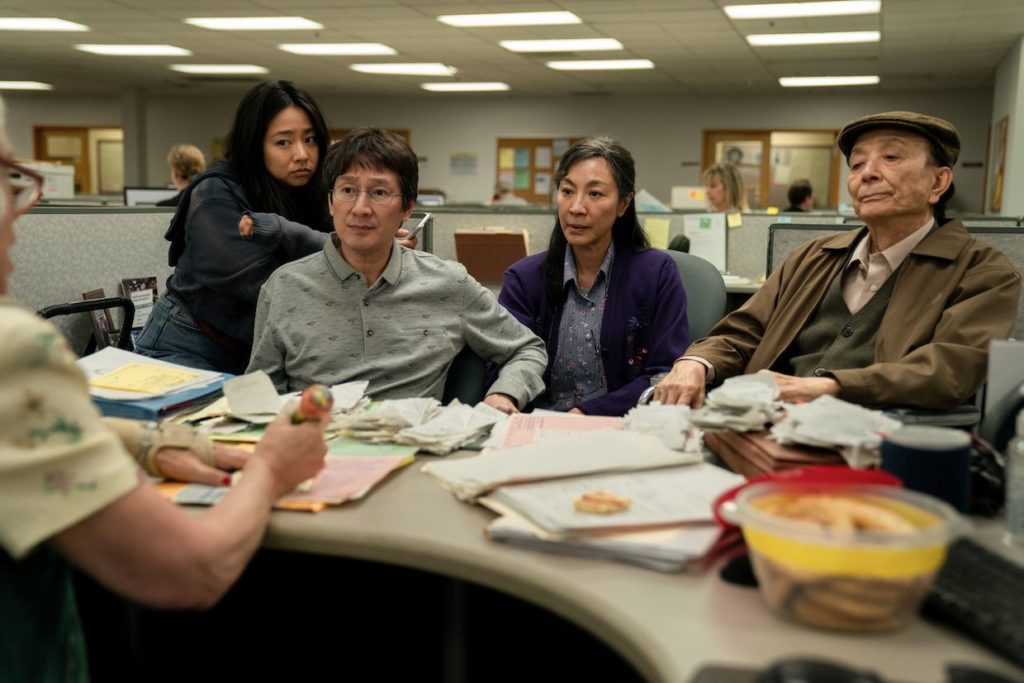
Filmmaker: Tell me more about the building you used for the IRS location.
Seiple: We scouted that building many months before we shot, because we were looking for a muse. The script had been written, but we wanted to find a location that we knew we could work with and maybe we would rewrite or reblock scenes around the structure of the building. This building was in Simi Valley, about 45 minutes outside of L.A., and at first we thought it was too big. It was really cool and felt really weird and 1980s, which we liked, but the scale was just too big for what we were going for. Then we spent a month looking for other places and nothing really compared. So, we came back and convinced our production designer Jason Kisvarday that we could figure out a way to shoot it and not have to fill 500 cubicles’ worth of office supplies and background. Jason actually designed around resolution. So, all the desks around Deirdre [the IRS auditor played by Jamie Lee Curtis] are fully kitted out and well dressed, the next desks [closest to camera] had monitors made of paper slapped onto cardboard, then 20 desks away it’s just construction paper. There’s no detail. It’s just color. So, we really designed around how to simplify dressing the location.
For lighting it, we used Titan tubes, which are LED fluorescents that are wireless. For most of it we embraced the natural fluorescents, but there’s a whole sequence where [the film’s multiverse destroying villain Jobu Tupaki is first revealed in their universe and her and Michelle have a very awkward fight/conversation. For that one, we swapped out the whole hallway, put in Titans and spent about two days programming all these different lighting moves to flicker and change into rainbows to show Jobu flexing her power. It was a lot of work, though, and we didn’t really have a rigging team. So, our best boy electric Michael Beckman bought stilts and would go around the building at about eight feet tall replacing fixtures every day for the next set we were doing.
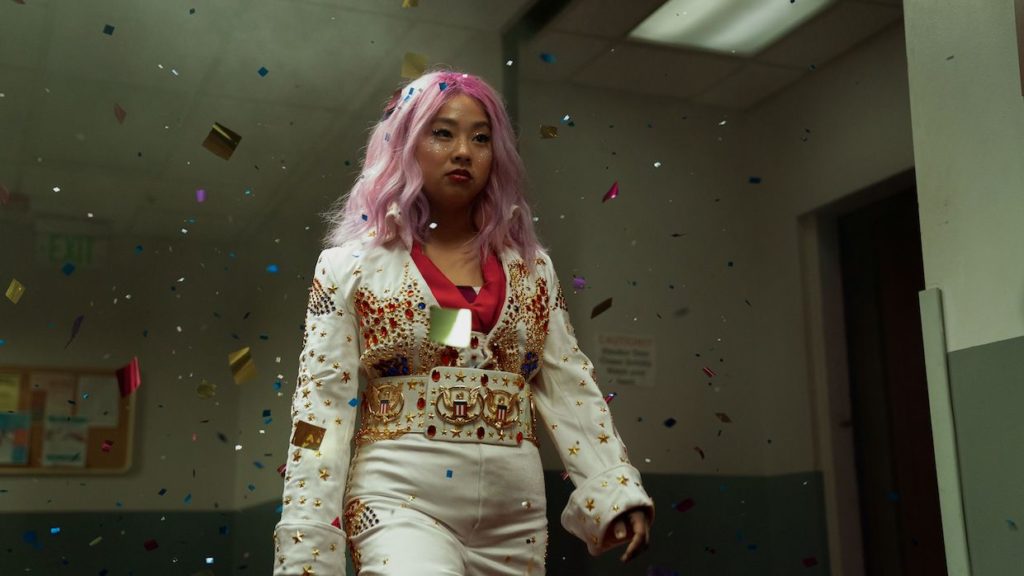
Filmmaker: Those Astera Titan tubes you were using are battery powered so you don’t have to hardwire them?
Seiple: Actually, to do them in pixel mode and have them react instantaneously to adjustments, they have to be hardwired. So, at first it sounded great: “Oh, we’ll just throw some Titan tubes in the ceiling and call it a day.” Then my gaffer Matt Ardine was like, “No, we have to go through the entire ceiling and cable them.” So, I think they spent two days rigging that one hallway. Those lights are very malleable, but if you want full control and instant response time you do have to wire them.
Filmmaker: Let’s talk about the fanny pack fight scene with Ke [which you can watch here in this New York Times “Anatomy of a Scene”]. The fight choreographers on the film are the Le brothers, who Daniels found on YouTube. Did they shoot any previs in prep?
Seiple: They did. We didn’t have much time to shoot that fanny pack scene. It was the first real bump in the road for us, the first day we went into overtime. The Daniels don’t really do that. They want to shoot our days and get everyone home, well fed and well slept. It was very hard to shoot that scene, but what made it less difficult was the Le brothers. I met them and Ke for the first time at a gym somewhere deep outside of L.A. and they’d choreographed this insane fight sequence. The Daniels had given them the arc of it and the initial blocking and they built a five-minute sequence with all sorts of ridiculousness and a lot of humor. When we showed up they had basically shot and cut together a whole sequence that was phenomenal. Then the Daniels worked with them to incorporate beats and different ideas. They were huge muses. I remember the day I was first shown their stuff on YouTube and I was like, “Oh, this is the secret sauce. This is how we’re going to make these fights next level.”
The other challenge with shooting in that IRS building was that there’s a massive atrium and we didn’t have the money to actually light it. We were shooting in winter, so at 5 pm we lost all of our light. So, we’d have to basically shoot out the direction facing the atrium, then the remaining four or five hours [of our shoot day] we’d shoot back facing the elevator bank and have to bring in an HMI and bounce it into the ceiling [to simulate the sunlight that was coming through the atrium]. It didn’t really match, but it did enough to make it feel like it was potentially still daytime.
Filmmaker: How did you get that slow motion shot of the fanny pack strap sliding through Waymond’s fingers when he first slings it at the security guards?
Seiple: That was a pick-up shot. Once we’d move on to the next scene, we had our second camera run back to the elevators to get that shot. It was done on the Alexa Mini at 200 frames per second and we had to switch to sphericals, which we had to do for anything over 48 frames per second. The whole movie was done on Alexa Minis.
Filmmaker: Another shot I love in that scene is when Waymond is on his back and he’s swinging the fanny pack around a few inches off the ground. It looks like the camera is rigged to the fanny pack.
Seiple: Our key grip, Tom Johnson, built a small platform, almost like a little furniture dolly, that was just plating and four wheels. You know how, at the start of a sprint, you crouch to get ready to spring? I started like that and then just ran in an arc [pushing the dolly]. It was very simply done, basically just Ke holding onto the fanny pack as tight as he could while we raced around him. It looked kind of gnarly on the day. It was a little bumpy. Those are the shots that got stressful when we were under the gun because they were elaborate, but we didn’t have much time.
Filmmaker: When you were listing off the universes, you omitted one of my favorites—the 2001 “dawn of man” homage where the apes have hot dog fingers.
Seiple: (laughs) I was very excited about that. That was a pick-up, too, in Simi Valley in this public park across from our stages. We timed it to where we could shoot it at dawn so that the light wasn’t direct. That was just one camera with older anamorphics called Todd-AOs that are kind of funky and a little milky. We only had two monkeys—one was [co-director] Dan Scheinert and the other was one of our stunt men. We basically shot the murder sequence, then for the wide shot Dan Scheinert and our stunt man moved all around the rock and we duplicated them in post. So, I think there’s something like 20 monkeys in the shot, but in reality it was just two guys moving to different places and shaking their hot dog fingers at the air. I was really happy with how that came out. Using a children’s orchestra doing a rendition of [Also sprach Zarathustra] was really the chef’s kiss to it.
Filmmaker: What era are those Todd-AO anamorphics from?
Seiple: They were used a lot for music videos in the 1990s. They are older anamorphics, but I’m not sure [when they were made]. They’re very big and they’re very heavy. I should know more about them, I was more researched at the time.
Filmmaker: That’s okay. The shoot was like two years ago. You can only retain so much.
Seiple: I know. We worked with Keslow Camera andwere like, “What lenses do you have?” We used an interesting range of anamorphics—Atlas anamorphics, then Scorpio anamorphic just for wide shots, because most anamorphics get really bendy when you go really wide and we wanted to keep it anamorphic but not have the whole world look like it was rubbery and distorted.
Filmmaker: There’s a scene where Evelyn and Jobu link up their fingers and Evelyn peers through this “hand bridge.” There’s a macro POV that travels through the hands. What lens did you use for that?
Seiple: That was a Venus Optics Laowa Probe lens. It is about as thick as a magic marker and about a foot and a half long. It looks kind of silly, like a lens got shrunk down and stretched out. I bought one before this movie. I think they’re like $1,500. So, it’s the most affordable lens I’ve ever bought. (laughs) They actually have LEDs that are built into the front of the lens. So, if you’re putting the lens in somewhere dark you can frontlight it, but we didn’t do that. I think we shoved some LEDs and diffusion into the palm of one of the actors. We sent our B-camera back for that shot. It’s actually not the camera that moves. It’s the actors moving their hands toward the camera to create that effect.
Filmmaker: Let’s talk about the sequence where Evelyn gets pulled backward through all these different worlds. Daniel Kwan shot those background plates just going through his everyday life.
Seiple: Yeah, every time Daniel went to a park or on vacation or an airport, he’d pull out this camera— a very tiny GoPro-esque thing—and just walk in a straight line and shoot. We tried to basically mimic the intensity and color of the different worlds Evelyn flashes through by making this tunnel of LED panels. You can get some very cheap ones that have the image on them but don’t look real enough to actually [be on camera]. Then you can get some very nice panels. A lot of times now for car work, people will get high resolution panels, put those outside the windows of the car and shoot them with, like, trees flying by. We had to negotiate with production, like “How much resolution can we afford?” We opted for lower res LED panels just to create a wall of video that would reflect the environments she was being pulled through. Again, this was something that we built in L.A. to figure out the timing of it and how to work it, then we shot it with Michelle’s stand-in on greenscreen [with the panels providing interactive light around her]. Once we had built it and figured out the dimensions and how to time it out, we emailed the designs and schematics to Paris, and they had to re-build it and shoot it with Michelle.
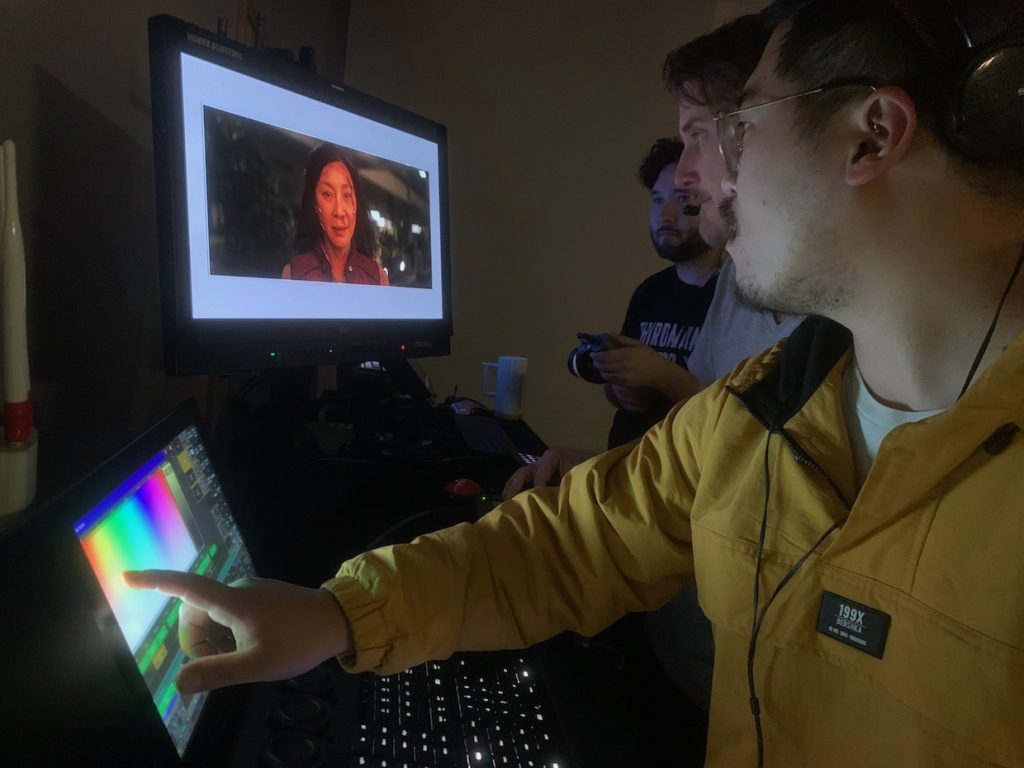
Filmmaker: Daniel Kwan mentioned on Twitter that your gaffer Matt Ardine built some custom lighting rigs for the movie.
Seiple: Matt and I have been working together for a decade and actually went to school together as well. There’s a big swirling color light that orbits around Michelle throughout the film, which is a reference to Henri-Georges Clouzot’s Inferno. There’s a constant theme of moving light of different colors around her face, connected to the idea that each color is a different version of her. We spent a long time trying to figure out how to make that look good and how to get the light chase to work out. We started building circles and squares of Titan tubes for that light chase, because those tubes have individual pixels that you can control. So, you can send a color chase through [an individual tube]. We ended up building a triangle light of three tubes next to each other and found a way to rig the camera in that triangle. The fun part was we could actually have the directors come up to the lighting board and swirl the colors with their fingers to mimic what they thought the characters were feeling.
Matt and his team also built security lights with these little AX3 pucks that could flash and flicker. So, I guess it was less that Matt was creating custom lights and more that he was able to bring a lot of control and personality to the lighting design. He was able to build lighting structures and rigs that had a character and a persona to them, which was a big part of our storytelling.
Filmmaker: Let’s finish up with a “cinematographer’s choice.” Any shot or scene that I didn’t ask about that you want to get into?
Seiple: The hardest scene to shoot was the fight on the stairs in the lobby of the IRS building. A fight sequence on stairs sounds wonderful, but then you realize there’s nowhere to put the camera. We did get to bring in a Technocrane for those days and everyone got really excited: “Oh, we’ve got a Technocrane! We can do all these crazy moves.” And it was like, “No, we just need a way to put a camera over a ledge for two days straight.” (laughs) For that whole sequence we referenced [Wong Kar-wai’s] The Grandmaster and this beautiful train sequence that’s all cast in golden, yellow light. We blacked out the whole atrium, covered it in LiteMats and then created a custom pulse of light to the rhythm of the scene that gets more intense as Evelyn fights her way up the stairs. It was kind of fun to shoot, but pure chaos with these two big cranes crammed into this tiny lobby. We also had two industrial fans blowing paper everywhere. We had actors on wires so we could get Michelle onto Harry’s back. We had to get Alpha Gong Gong [played by James Hong] into a mech suit and put that onto the stairs. It was pretty absurd and took a long time, but watching it now it’s fun to see how elegant it came out. If you took out the slow motion and kept the sound from the day of the shoot, it was pure chaos. After every take you’d have the production assistants, the stunt team and the directors all picking up paper out of the water fountain and rushing it back over to this pile to be blown around again. It was a messy but fun way to make something very stupid but very beautiful.
